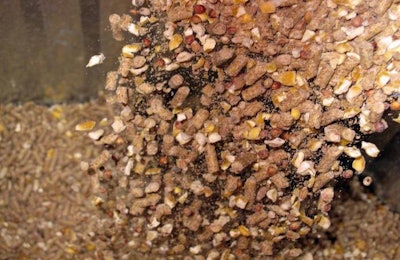
With animal feed accounting for between 60 and 70 percent of total production costs, poultry and livestock farmers in Rwanda are seeking ways to manage their costs.
With commercial feed costing RWF200,000-350,000 (US$238-417) per metric ton, many farmers are producing their own feeds, reports New Times, but that can lead to reduced productivity.
“Due to lack of affordable quality feeds, some farmers are blending animal feed ingredients on their own, yet they do not have scientifically approved formula to determine the amount of protein, fiber, fat, and energy among other nutrients needed to produce nutritious feeds,” said Manasseh Ndahabwa, a nutritionist for ProDev Rwanda Ltd.
At the ProDev feed mill in the district of Rwamagana in Eastern Province, production started in August last year with a monthly output of 40 metric tons. That figure has since risen to between 700 and 900 metric tons.
There are four feed mills in production in Rwanda, and a fifth is under construction.
Responding to rising feed costs
Egg prices have not risen in line with feed costs, one poultry farmer said, leading to vanishing returns.
To help farmers, the government has already waived value-added tax on feeds from commercial feed mills.
Nevertheless, feed costs have been escalating over recent years. Not long ago, a typical price was RWF180,000 (US$214) per metric ton, leading feed manufacturers and farmers to call on government to subsidize locally produced and imported raw materials. Main feed ingredients are corn, rice bran, wheat bran, and fish products, and soybean products from India, according to Gahiga Gashumba, chairperson of National Dairy Farmers Federation of Rwanda.
Making inferior feeds leads to reduced animal productivity, so the first solution is to access low-cost raw materials, said Ernest Habimana, sales executive for Gorilla Feed, whose feed mill is in the province of Kigali.
Potential for growth in Rwandan agriculture
Rwanda Agriculture Board figures put the country’s livestock population at 1.4 million cattle, 1 million pigs, and 5 million poultry.
According to agriculture minister Dr. Gerardine Mukeshimana, farming contributes to 30 percent of the country’s GDP, and 10 percent is from livestock, reports All Africa. Speaking at the recent national agricultural show in Kigali, she said these sectors have enormous potential for exports and wealth creation as well as nutrition for families.
“Farmers should raise productive livestock through quality breeds, proper animal feeding, grass storage, and use of other animal feed that has been exhibited here to contain effects of dry spells,” she said.
A year ago, a new hatchery was inaugurated in Rwanda’s Northern Province, and a feed mill in Eastern Province, bringing the prospects of lower costs, healthier chicks and quality to the country’s poultry farmers.

















